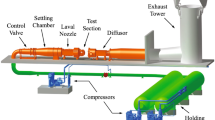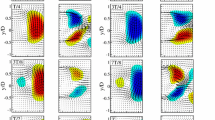Abstract
The influence of leading edge modification on the time-averaged and instantaneous flow around a fan airfoil is investigated by particle image velocimetry (PIV), schlieren imaging and high-speed shock shadowgraphs in a transonic cascade windtunnel. In addition to a global characterization of the time-averaged flow using PIV, the instantaneous passage shock position was extracted from single-shot PIV measurements by matching the tracer velocity across the normal shock with an exponential fit. The instantaneous shock positions are assigned to a probability density distribution in order to obtain the average position and the range of fluctuations of the eroded and reference leading edge. The profiles are used to estimate the response time of the particles to the normal shock which was found to be in the sub-microsecond range. Averaged PIV measurements and the probability density of shock position from both geometries are obtained at near stall and choked conditions. In order to extract the frequency range of the shock motion, the shadow of the shock wave was tracked using high-speed shadowgraphy. The paper also provides details on the experimental implementation such as a specifically designed light-sheet probe.














Similar content being viewed by others
Abbreviations
- \(c\) :
-
Chord length
- \(d\) :
-
Diameter
- \(f\) :
-
Focal length
- \(f_\#\) :
-
\(f\)-Number, lens aperture
- \(M\) :
-
Mach number
- \(m\) :
-
Magnification
- \(p\) :
-
Blade pitch
- \(u\) :
-
Velocity magnitude
- \(\beta\) :
-
Incidence angle
- \(\tau\) :
-
Particle relaxation time
- \(\xi\) :
-
Particle relaxation length
- 1:
-
At cascade entry
- 0,1:
-
Upstream and downstream of the shock
- n :
-
Normal to shock
- s :
-
Stagger parameter
- p :
-
Particle parameter
- ADP:
-
Aerodynamic design point (near choking)
- AVDR:
-
Air velocity density ratio
- BLE:
-
Blunt leading edge
- DFT:
-
Discrete Fourier transformation
- ODP:
-
Off design point (near stall)
- RANS:
-
Reynolds-averaged Navier–Stokes
References
Bourgoing A, Reijasse P (2005) Experimental analysis of unsteady separated flows in a supersonic planar nozzle. Shock Waves 14(4):251–258. doi:10.1007/s00193-005-0269-2
DeFatta D, Lucas J, Hodgkiss W (1988) Digital signal processing. Wiley, New York
Elsinga G, van Oudheusden B, Scarano F (2005) Evaluation of aero-optical distortion effects in PIV. Exp Fluids 39(2):246–256. doi:10.1007/s00348-005-1002-8
Estruch D, Lawson NJ, MacManus DG, Garry KP, Stollery JL (2008) Measurement of shock wave unsteadiness using a high-speed schlieren system and digital image processing. Rev Sci Instrum 79(12):126108
Ghenaiet A (2012) Study of sand particle trajectories and erosion into the first compression stage of a Turbofan. J Turbomach 134(051025):1–17. doi:10.1115/1.4004750
Ghenaiet A, Elder R, Tan SC (2001) Particle trajectories through an axial fan and performance degradation due to sand ingestion. In: Proceedings of ASME Turbo Expo, New Orleans, Louisiana. ASME
Giebmanns A, Schnell R, Steinert W, Hergt A, Nicke E, Werner-Spatz C (2012) Analyzing and optimizing geometrically degraded transonic fan blades by means of 2d and 3d simulations and cascade measurements. In: Proceedings of ASME Turbo Expo Copenhagen, Denmark
Goodhand MN, Miller RJ (2011) Compressor leading edge spikes: a new performance criterion. J Turbomach 133:021,006-1-8
Hamed A, Tabakoff W, Wenglarz R (2006) Erosion and deposition in turbomachinery. J Propuls Power 22(2):350–360. doi:10.2514/1.18462
Hergt A, Klinner J, Steinert W, Beversdorff M, Giebmanns A, Schnell R (2014) The effect of an eroded leading edge on the aerodynamic performance of a transonic fan blade cascade. In: Proceedings of ASME Turbo Expo Duesseldorf, Germany
Humble RA, Scarano F, van Oudheusden BW (2007) Particle image velocimetry measurements of a shock wave/turbulent boundary layer interaction. Exp Fluids 43(2–3). doi:10.1007/s00348-007-0337-8
Melling A (1986) Seeding gas flows for laser anemometry. In: Proceedings of the conference on advanced instrumentation for aero engine components, 8.1
Melling A (1997) Tracer particles and seeding for particle image velocimetry. Meas Sci Technol 8:1406–1416
Ragni D, Schrijer F, van Oudheusden B, Scarano F (2011) Particle tracer response across shocks measured by PIV. Exp Fluids 50(1):53–64
Scarano F, van Oudheusden B (2003) Planar velocity measurements of a two-dimensional compressible wake. Exp Fluids 34:430–441
Settles G (2006) Schlieren & shadowgraph techniques. Springer, Berlin
Steinert W, Fuchs R, Starken H (1992) Inlet flow angle determination of a transonic compressor cascade. ASME J Turbomach 114(3):487–493
Suder KL, Chima RV, Strazisar AJ, Roberts WB (1995) The effect of adding roughness and thickness to a transonic axial compressor rotor. J Turbomach 117:491–505. doi:10.1115/1.2836561
Werner-Spatz C, Giebmanns A, Döbbener G, Hönen H (2012) Analysen zur Optimierung der Instandhaltung von Flugtriebwerksverdichtern in Hinblick auf Wirtschaftlichkeit und Umweltfreundlichkeit. In: Proceedings of Deutscher Luft- und Raumfahrtkongress
Willert C, Mitchell D, Soria J (2012) An assessment of high-power light-emitting diodes for high frame rate schlieren imaging. Exp Fluids 53:413–421. doi:10.1007/s00348-012-1297-1
Acknowledgments
The authors would like to thank Manfred Beversdorff, Wolfgang Steinert and Sebastian Grund for the support during the PIV and high-speed shadowgraph campaigns. Part of the work reported in this paper is performed under the German Aviation Research Program (LuFo IV) funded in part by the Federal Ministry of Economics and Technology. In this context, Lufthansa Technik AG is acknowledged for the good cooperation. Additional funding is provided by the EU-project AFDAR (Advanced Flow Diagnostics for Aeronautical Research, project No. 265695) of the 7th Framework Program whose support is gratefully acknowledged. Finally, the authors would like to thank ANSYS for providing the geometry of the reference blade.
Author information
Authors and Affiliations
Corresponding author
Rights and permissions
About this article
Cite this article
Klinner, J., Hergt, A. & Willert, C. Experimental investigation of the transonic flow around the leading edge of an eroded fan airfoil. Exp Fluids 55, 1800 (2014). https://doi.org/10.1007/s00348-014-1800-y
Received:
Revised:
Accepted:
Published:
DOI: https://doi.org/10.1007/s00348-014-1800-y




